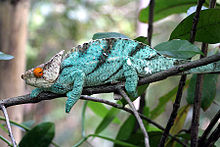Calumma
| Calumma Temporal range:
| |
|---|---|

| |
Calumma parsonii
| |
| Scientific classification | |
| Domain: | Eukaryota |
| Kingdom: | Animalia |
| Phylum: | Chordata |
| Class: | Reptilia |
| Order: | Squamata |
| Suborder: | Iguania |
| Family: | Chamaeleonidae |
| Subfamily: | Chamaeleoninae |
| Genus: | Calumma Gray, 1865 |
| Type species | |
Chamaeleon cucullatus
, 1831 | |
| Diversity | |
| 41 species | |

Calumma is a
Species groups
Four species groups are recognised within the genus Calumma (originally proposed by
Calumma furcifer species group
Contents: Calumma furcifer, C. gastrotaenia, C. marojezense, C. guillaumeti, C. andringitraense, C. glawi, C. vencesi
Species characterised by typically green body colouration, sleek body form, and generally no occipital lobes (flaps of skin posterior to the head; present only in C. glawi) and no rostral appendage (present only in males of C. furcifer).[4]
Calumma cucullatum species group
Contents: Calumma cucullatum, C. crypticum, C. amber, C. tsaratananense, C. hafahafa, C. hilleniusi, C. peltierorum, C. malthe, C. brevicorne, C. jejy, C. tsycorne
Species characterised by distinct occipital lobes and generally a single bony rostral appendage that is larger in males than females.[4]
Calumma nasutum species group
Contents: Calumma nasutum, C. fallax, C. gallus, C. guibei, C. boettgeri, C. linotum, C. gehringi, C. uetzi, C. lefona, C. juliae, C. vatosoa, C. vohibola, C. peyrierasi, C. roaloko
Species characterised by a soft dermal rostral appendage (generally present in males and absent in females).[4] The following members possess occipital lobes: C. guibei, C. boettgeri, C. linotum, C. gehringi, C. uetzi, C. lefona, C. roaloko, and C. juliae.[7][8] These taxa are collectively referred to as the C. guibei species complex.[5][7] Occipital lobes are absent from all other species.[4] The assignment of C. peyrierasi to this group remains a subject of uncertainty.[9]
Calumma parsonii species group
Contents: Calumma globifer, C. ambreense, C. oshaughnessyi, C. parsonii, C. capuroni
Species characterised by large body size, males with paired rostral appendages, and some species with small occipital lobes.[4]
Species
The following 41 species are recognized as being valid as of October 2020:
- Calumma amber Raxworthy & Nussbaum, 2006 – Amber Mountain chameleon
- Calumma ambreense (Ramanantsoa, 1974)
- Calumma andringitraense (Brygoo, C. Blanc & Domergue, 1972)
- Calumma boettgeri (Boulenger, 1888) – Boettger's chameleon
- Calumma brevicorne (Günther, 1879) – short-horned chameleon
- Calumma capuroni (Brygoo, C. Blanc & Domergue, 1972) – Madagascar chameleon
- Calumma crypticum Raxworthy & Nussbaum, 2006 – blue-legged chameleon
- Calumma cucullatum (Gray, 1831) – hooded chameleon
- Calumma emelinae Prötzel, Scherz, Ratsoavina, Vences & Glaw, 2020
- Calumma fallax (Mocquard, 1900) – deceptive chameleon
- Calumma furcifer (Vaillant & Grandidier, 1880) – forked chameleon
- Calumma gallus (Günther, 1877) – blade chameleon
- Calumma gastrotaenia(Boulenger, 1888) – Perinet chameleon
- Calumma gehringi Prötzel, Vences, Scherz, Vieites & Glaw, 2017
- Calumma glawi Böhme, 1997 – Glaw's chameleon
- Calumma globifer(Günther, 1879) – globe-horned chameleon or flat-casqued chameleon
- Calumma guibei (Hillenius, 1959) – Guibe's chameleon
- Calumma guillaumeti (Brygoo, C. Blanc & Domergue, 1974)
- Calumma hafahafaRaxworthy & Nussbaum, 2006 – bizarre-nosed chameleon
- Calumma hilleniusi (Brygoo, C. Blanc & Domergue, 1973)
- Calumma jejy Raxworthy & Nussbaum, 2006 – Marojejy Peak chameleon
- Calumma juliae Prötzel, Vences, Hawlitschek, Scherz, Ratsoavina & Glaw, 2018
- Calumma lefona Prötzel, Vences, Hawlitschek, Scherz, Ratsoavina & Glaw, 2018
- Calumma linotum (L. Müller, 1924) – Amber Mountain blue-nosed chameleon
- Calumma malthe (Günther, 1879) – yellow-green chameleon
- Calumma marojezense (Brygoo, C. Blanc & Domergue, 1970)
- Calumma nasutum (A.M.C. Duméril & Bibron, 1836) – big-nosed chameleon, pimple-nose chameleon
- Calumma oshaughnessyi (Günther, 1881) – O'Shaughnessy'schameleon
- chameleon
- Calumma peltierorum Raxworthy & Nussbaum, 2006 – Peltier's chameleon
- Calumma peyrierasi (Brygoo, C. Blanc & Domergue, 1974) – Brygoo's chameleon, Peyriéras's chameleon[10]
- Calumma radamanus (Mertens, 1933)
- Calumma ratnasariae Prötzel, Scherz, Ratsoavina, Vences & Glaw, 2020[11]
- Calumma roaloko Prötzel, Lambert, Andrianasolo, Hutter, Cobb, Scherz & Glaw, 2018 – Two-toned soft-nosed chameleon[8]
- Calumma tarzan Gehring, Pabijan, Ratsoavina, J. Köhler, Vences & Glaw, 2010 – Tarzan chameleon, Tarzan's chameleon
- Calumma tjiasmantoi Prötzel, Scherz, Ratsoavina, Vences & Glaw, 2020
- Tsaratananachameleon
- Calumma tsycorne Raxworthy & Nussbaum, 2006 – blunt-nosed chameleon
- Calumma uetzi Prötzel, Vences, Hawlitschek, Scherz, Ratsoavina & Glaw, 2018 – Uetz's soft-nosed chameleon
- Calumma vatosoa Andreone, Mattioli, Jesu & Randrianirina, 2001
- Calumma vencesi Andreone, Mattioli, Jesu & Randrianirina, 2001 – Vences'schameleon
- Calumma vohibola Gehring, Ratsoavina, Vences & Glaw, 2011
Nota bene: A binomial authority in parentheses indicates that the species was originally described in a genus other than Calumma.
References
- PMID 20826471.
- PMID 31924840.
- ^ Vitt, Laurie. "Chameleon". www.Britannica.com. Retrieved 26 August 2023.
The longest chameleon in the world is Parson's chameleon (Calumma parsonii), which may grow up to 69.5 cm (about 27 inches) long.
- ^ ISBN 978-3929449-01-3.
- ^ .
- PMID 23536596.
- ^ .
- ^ ISSN 1860-0743.
- ISSN 1860-0743.
- ISBN 978-1-4214-0135-5. (Calumma peyrierasi, p. 205).
- .
Further reading
- Gray JE (1865). "Revision of the Genera and Species of Chamæleonidæ, with the Descriptions of some New Species". Proc. Zool. Soc. London 1864: 465–479. (Calumma, new genus, p. 476).
